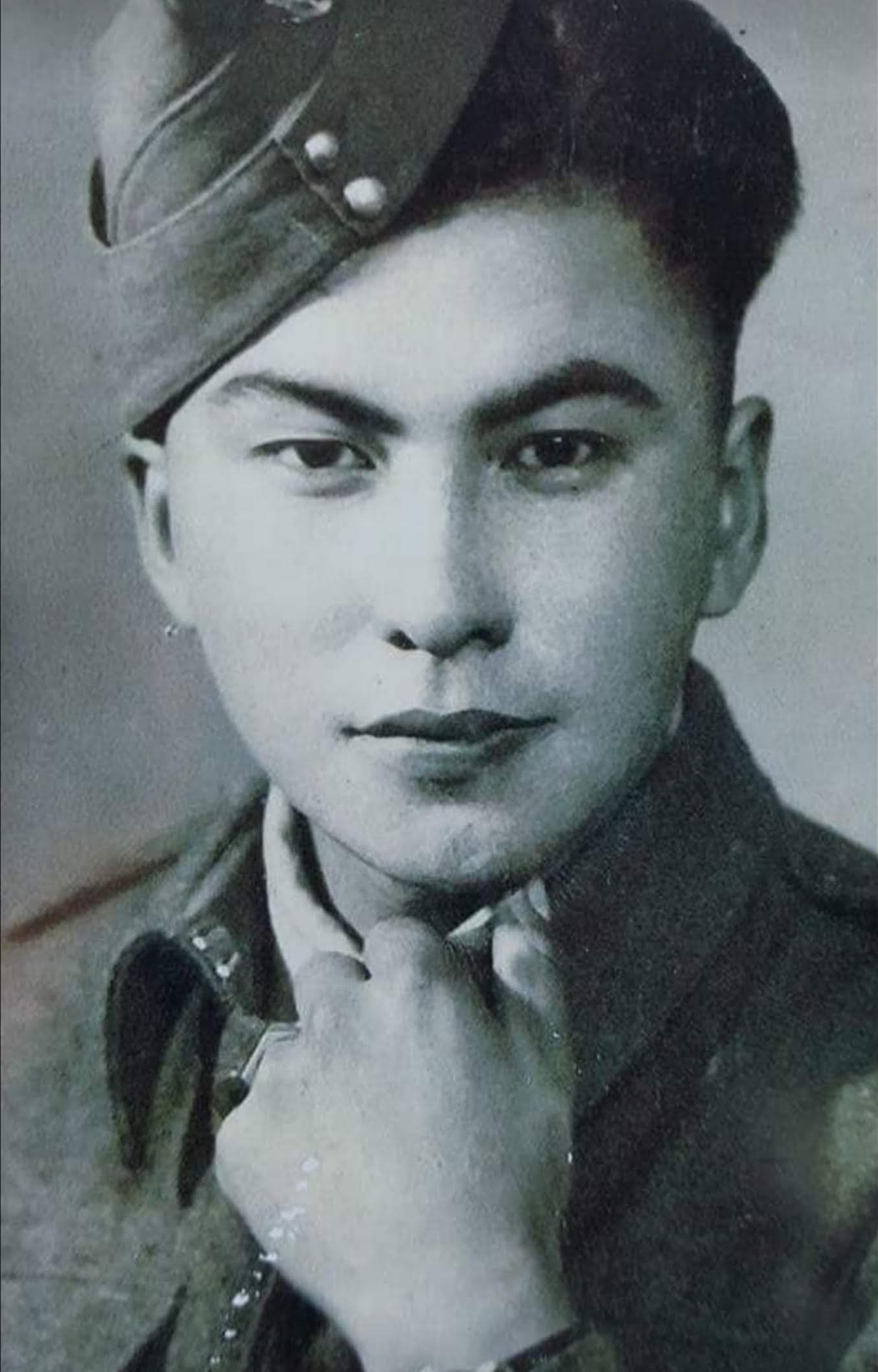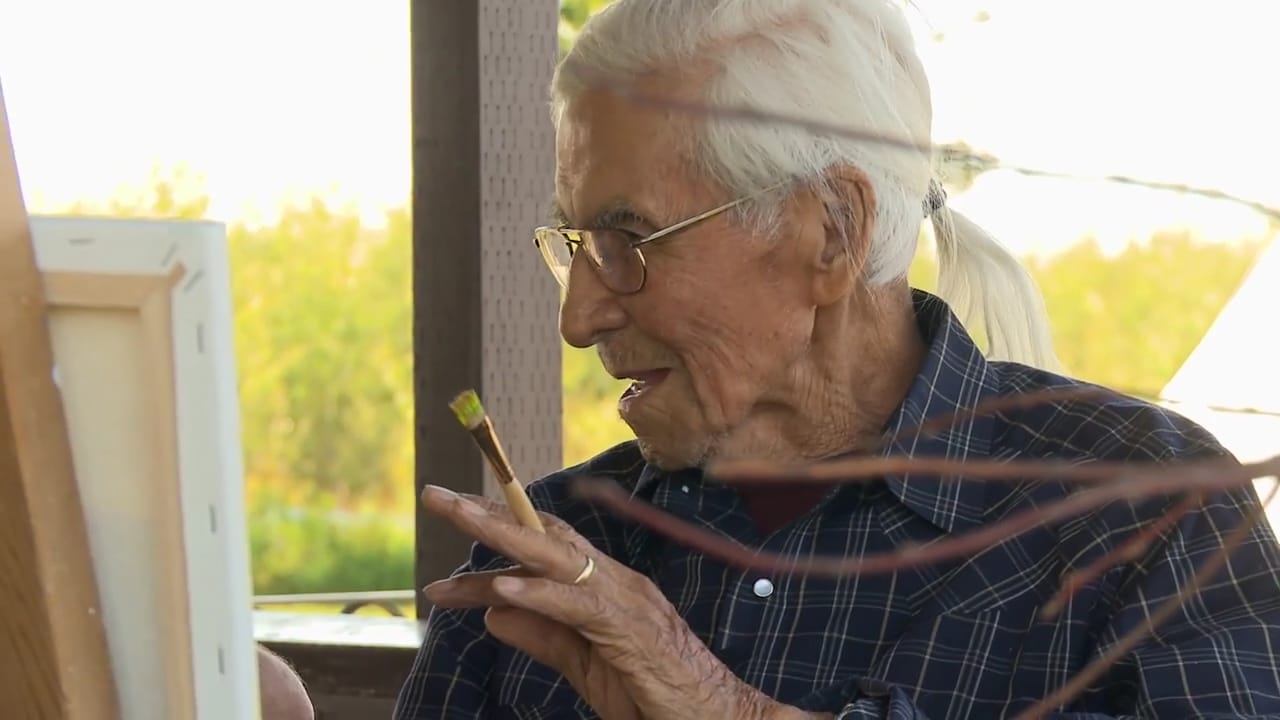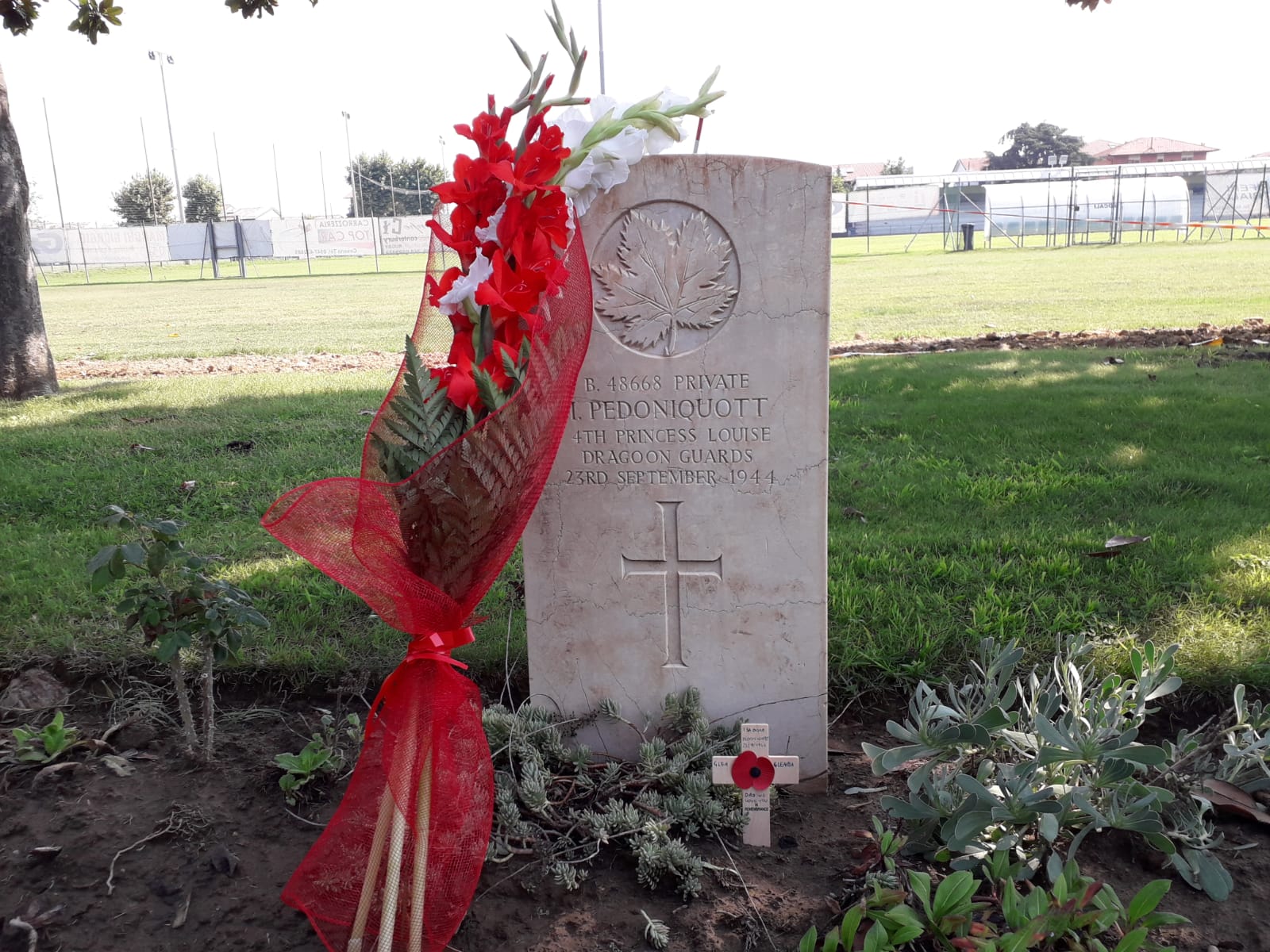“The American Indians who Liberated Italy”, this is the title of your book: who are they?
They are the thousands of native soldiers who belonged to Canadian and American tribes, who came to fight in Europe to free us from nazi-fascism. Many are buried in Commonwealth and in the Americans in Italy cemeteries. In Agira (Sicily), near the Moro River in Ortona, Cassino, Rome, Gradara in the Marche region, but also in the four burial grounds of Romagna, namely in Cesena, Coriano close to Rimini, Ravenna and Villanova di Bagnocavallo. Natives who joined the Canadian army were all volunteers. Volunteers in a war for freedom, although, at the time, they themselves suffered discrimination inside reservations. Although they did not have the right to vote in Federal elections, drink a beer in a pub with the “whites”. As children they were torn from their families and placed in religious Catholic and Protestant “residential schools”, where they became victims of unspeakable violence, of sexual abuse. They were denied the possibility to speak their own language. This book tells their stories both in the “Italian Campaign”, but also of those who were fortunate enough to return home safely, and continue the quest to conquer civil and environmental rights. Some became important Chiefs, others became artists and actors, like Brummet Echohawk of the Pawnees, the Cree Henry Beaudry and the Objibwa Wilmer Nadjiwon.
“I Pellerossa che Liberarono l’Italia”, questo è il titolo del tuo libro: chi sono?
Sono le migliaia di soldati nativi delle tribù del Canada e degli Stati Uniti che vennero a combattere in Europa per liberarci dal nazifascismo. Tanti di loro anche in Italia e almeno una sessantina sono sepolti nei cimiteri di guerra del Commonwealth e americani in Italia. Ad Agira in Sicilia, il Moro River a Ortona, Cassino, Roma, Gradana nelle Marche, i quattro cimiteri della Romagna a Cesena, Coriano vicino a Rimini, Ravenna e Villanova di Bagnocavallo. I nativi che vestirono le divise dell’esercito canadese erano tutti volontari. Volontari in una battaglia di libertà nonostante a quel tempo fossero discriminati nelle loro riserve. Nonostante non potessero nemmeno votare alle elezioni federali, bere in un pub insieme ai ‘bianchi’, nonostante da bambini venissero strappati alle loro famiglie e portati nelle ‘scuole residenziali’ religiose cattoliche e protestanti dove subirono violenze indicibili, anche sessuali e non potevano parlare la loro lingua. Il libro racconta sia le loro storie nella “Campagna d’Italia” che, per chi ebbe la fortuna di tornare a casa, le loro lotte per i diritti civili e ambientali. Alcuni diventarono importanti capi tribù, altri anche artisti e anche attori in film e telefilm come il Pawnee Brummet Echohawk, il Cree Henry Beaudry, l’Ojibwa Wilmer Nadjiwon.


Why was it important to write a book about the bond between Italy and the American Indian community?
I have been passionate about their stories since I was a child, passionate about the people whom in Italy we have always referred to, without malice, as: “Pellerossa”. Two years ago, during a summer vacation in Monument Valley, in the Navajo Nation of Arizona, I met an old veteran “Code Talker”. I asked him if they had faught in Italy as well. He told me to search further north, in Canada. Their example as people who have always suffered discrimination, yet decide to fight for the freedom of others, of Italians, represents the highest form of sense of justice, humanitarianism and, solidarity. I was also very happy to discover the story of two Native Sicilian-Naq’Nazdli. Jack and James Rossetti from Fort St. James in British Columbia. They were sons to Sam Rossetti, a gold digger who fell in love with the daughter of a Chief. They found themselves fighting difficult battles; D-Day, Juno Beach and in the Normandy landings.
Perchè hai ritenuto importante scrivere un libro che narra del legame che unisce l’Italia ai Nativi Indiani?
Sin da bambino mi sono appassionato alle loro storie, di quelli che in Italia abbiamo sempre chiamato, senza alcun termine dispregiato ‘pellerossa’ tanto che diversi libri pro nativi utilizzano tutt’ora qui questo termine. Un’estate di due anni fa in un viaggio nella Monument Valley nella Navajo Nation in Arizona un anziano veterano ‘code talker’ alla mia domanda se loro avessero combattuto anche in Italia mi rispose di cercare a nord…verso il Canada. La loro storia, di popoli ancora discriminati, che combattono per la libertà di un altro popolo, quello italiano è la più alta rappresentazione di senso di giustizia, altruismo, solidarietà umana. In più sono stato felicissimo di scoprire la storia di due nativi siciliano-naq’nazdli. I fratelli Jack e James Rossetti da Fort St. James nella British Columbia appartenenti alla tribù dei Naq’nazdli Whutten. Erano figli di ‘Sam’ Rossetti un cercatore d’oro di Palermo che si innamorò della figlia del capo tribù…A loro toccò il difficile compito del D-Day a Juno Beach e la campagna di Normandia.

Is there a lesson to be learned from your book?
First of all it’s important for Italians to know about this story, since it has been buried for seventy-five long years. We are planning to publish the book in English as well. This would also be very important because several Native Indian tribes in Canada would like future generations to know about the history of their ancestors, about the stories of their grandfathers and fathers who faught to liberate Italy. Another beautiful idea would be to have the possibility to organize an art exhibit in Italy with Henry Beaudry and Brummet Echohawk’s paintings, including the forty sketches portraying the Italian campaign. These pieces of art are in care of Brummet Echohawk’s grandson, Mark Ellebarger, a friend who wrote a beautiful book about the Native Indian soldiers of the 45a Us Infantry Division in Italy and Wilmer Nadjiwon’s wooden sculptures. Art and history, hand in hand. I am happy to have been able to write about these unspoken heroes of the Italian campaign. I believe all allied soldiers who lost their lives in Italy between 1943 and 1945 deserve more attention. The ‘D-Day dodgers’ were not on vacation, as the famous song says. Tens of thousands died in Italy. To share the stories of such simple yet heroic men is meaningful from a historical point of view. A citizen who ignores the history of his/her own nation is like a tree without roots, liable to fall at the first gust of wind. Being aware of our history is necessary in order to avoid committing the same mistakes over and over again. Instead of destroying statues I think it is vital to enhance education, social rights, and why not, even explain the dark side of certain historical figures. Education is always a better alternative to destruction. We must build bridges, not dig grooves between the people of the world.
Cosa vorresti si riuscisse a trarre dal tuo libro?
Per prima cosa è importante fare conoscere questa storia in Italia, visto che è rimasta sepolta per oltre settantacinque lunghi anni. Abbiamo diversi contatti per tradurre e pubblicare il libro in inglese. Questo sarebbe molto importante, perchè diverse tribù di nativi in Canada sono interessate a far conoscere la storia dei loro padri e nonni alle future generazioni. Se nasceranno altre possibilità sarà il destino a volerlo. Un sogno sarebbe anche organizzare una mostra itinerante in Italia dei quadri di Henry Beaudry e Brummet Echohawk, incluse le sue quaranta tavole-schizzi sulla campagna d’Italia custodite dal nipote Mark Ellenbarger, un amico che ha scritto un bellissimo libro sui soldati nativi della 45a Us Infantry Division in Italia e le sculture in legno di Wilmer Nadjiwon. Arte e storia a braccetto.
Io sono già felice di aver fatto conoscere le storie di questi eroi sconosciuti della “campagna d’Italia” facendoli uscire dall’oblio. In generale vorrei dire che tutti i soldati alleati caduti in Italia tra il 1943 e il 1945 meriterebbero maggiore attenzione. Non erano ‘D-day dodgers’ come affermava la canzone dell’epoca. Non erano in vacanza. Morirono a decine di migliaia in Italia. Condividere queste storie di uomini semplici ed eroici al tempo stesso, a mio avviso è importante per raccontare la Storia. Un uomo che non conosoce la Storia del proprio paese e dei popoli, è come un albero senza radici. Al primo soffio di vento rischia di cadere. Conoscere la Storia è importante per non ripetere gli errori del passato. Invece di distruggere statue, io penso sia importante potenziare l’educazione scolastica e i diritti sociali e perché no mettere a fianco di quei monumenti una targa che spiega anche aspetti oscuri di quei personaggi. Educare è sempre meglio di sradicare e distruggere. Dobbiamo costruire ponti, non creare solchi tra popoli.

Native Indians faught to free us from nazi-fascism. Today, do you think they enjoy the same rights and freedom as the rest of us?
They surely have more rights than seventy-five years ago when they came to fight for us in Europe and Italy. But the road to gaining full rights is still very long, although steps forward have been made. In my opinion, making steps forward is about conquering social rights. It’s about the right to education and being able to live with dignity. Instead, what I see, are sponsors with the power to change the names of professional American sports teams, merely to satisfy economic interests and save appearances. Things like this are pretty much useless. They are only a way to relieve our conscience.
I Nativi Indiani hanno combattuto per liberarci dal nazifascismo. Pensi che anche loro oggi godono dei nostri stessi diritti?
Oggi godono sicuramente di più diritti di settantacinque anni fa quando vennero a combattere per noi in Europa e in Italia. Ma è una battaglia ancora lunga anche se sono stati fatti diversi passi avanti. Per me i passi avanti sono quando si conquistano diritti sociali, educativi, economici per questi popoli. Temo invece che pressioni da sponsor potenti che fanno cambiare i nomi a squadre sportive professionistiche statunitensi solo per meri interessi economici e di ‘immagine’ servano a poco. Sono solo riverniciate di coscienza.

Native Indian culture is about brotherhood, it’s about love and respect for Mother Nature, it’s about generosity, consideration and it does not host greed. Can a comparison be drawn with white people’s culture?
War and peace coexist in every culture. Having said this, there is no doubt as to the fact that North American Indegenous culture embodies important values. Every society is different and that diversity deserves respect. However, the Native community shows us how sharing is more important than owning. If we shared more, we could learn a great deal from their culture. The entire world is called to face a common battle, to put political divides aside. We must change our lifestyles, to contrast pollution and climate change; problems caused by a western, consumerist economic model which has already begun to deplete humankind. Nature always finds a way to survive. If we respect Her, if we learn to have consideration of the delicate balances which rule all ecosystems, as the Native Indians do, She will always give and never take.
La cultura del Popolo dei Nativi Indiani è una cultura di fratellanza, di rispetto e di amore per Madre Natura, di condivisione, di altruismo e privo di avidità. Secondo te, la nostra cultura può essere accumunata alla loro?
Posto che nelle tradizioni di ogni popolo esistono sia tradizioni guerriere che di pace, è indubbio che le popolazioni indigene del Nord America siano contraddistinte da importanti valori. Ogni popolo è diverso, e va rispettato nella sua diversità, ma come insegnano loro l’importante è condividere più che possedere. Se impareremo a condividere di più anche noi riusciremo, senza sradicarli, ad apprendere importanti insegnamenti dalle loro culture. Il Mondo intero, al di là di divisioni politiche tra Stati, è chiamato ad una grande battaglia comune. Quella per cambiare stili di vita ed economia combattere inquinamento e cambiamenti climatici causati da un modello occidentale iperconsumista che travolgerà in primis gli uomini come sta già accadendo. Perché la natura sopravvive sempre e se la rispettiamo, se rispettiamo i suoi equilibri, come insegnano i nativi, fornisce a tutti di cui vivere e non toglie nulla a nessuno.
How can we honor the memory of the many American Indian heroes who gave their lives for our freedom?
We can learn and pass down their stories.Stories which were unheard of in Italy up until two months ago. Celebrate them not only as heroes who liberated us from a horrid dictatorship, from fascism, but as simple men who encountered the ugliest thing one could possibly find in life: war. We can reflect on their interior wounds, caused by this and previous tragic events. We can think about the Ojibwa Wilbur Nadjiwon who was sexually abused by a priest in a Spanish residential school in Ontario, or the Cree Henry Beaudry who was condemned to live with a terrible sense of guilt after being ordered to kill nine German prisoners. “War is hell” said the Metìs George Campion as he pulled out a little girl from the ruins, in Ortona, as he tore her from her dead mother’s arms. The woman had lost her life under the bombs of the “Italian Stalingrad”. Campion died a few months later in Pontecorvo as he broke through the “Hitler line”. He is buried in Cassino. The book also tells about stories of love between Scotland, Italy, the Native Indians and the two children born from the war. One is Len Bailey’s love story, the other is of an Italian half-blood who is still searching for his father, the Ojibwa Orville Jonston. It would be wonderful to see this family reunited, to witness a happy ending in a story of war…
Cosa possiamo fare per onorare la memoria degli eroi Nativi Indiani d’ America che hanno dato la vita per donarci la libertà?
Conoscere e tramandare le loro storie. Storie che in Italia erano sconosciute fino a due mesi fa. Celebrarli non solo come eroi che ci hanno liberato da una tremenda dittatura, quella fascista, ma come uomini semplici che hanno incontrato nella loro vita la cosa più brutta che possa capitare ad un uomo: la guerra. Ricordarli anche con le loro ferite interiori causate da questo evento e da quelli precedenti. Come quelle subite dall’Ojibwa Wilmer Nadjiwon che venne violentato da un prete nella scuola residenziale spagnola dell’Ontario, come il rimorso che violentò l’anima del cree Henry Beaudry al quale venne dato l’ordine di uccidere nove prigionieri tedeschi.durante l’avanzata. “La guerra è l’inferno” disse il metìs George Campion portando fuori dalle macerie di Ortona una bambina strappata dalle braccia della madre morta sotto i bombardamenti della ‘Stalingrado d’Italia’. Campion morì pochi mesi più tardi a Pontecorvo sfondando la “Linea Hitler” ed è sepolto a Cassino. A lui è intitolata una montagna nell’Alberta. Nel libro ci sono anche storie d’amore tra Scozia, Italia e questi nativi con due figli di guerra. Uno quello dell’amore di Len Bailey, l’altro con un figlio mezzosangue italiano ancora alla ricerca di suo padre, l’ojibwa Orville Jonston. Chissà che ora non riusciremo anche riunire questa storia nata nel buio della guerra…



